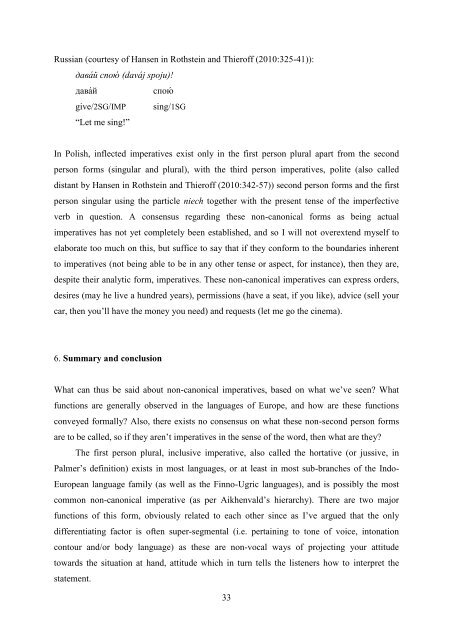The function of non-canonical imperatives in the languages of Europe
The function of non-canonical imperatives in the languages of Europe
The function of non-canonical imperatives in the languages of Europe
You also want an ePaper? Increase the reach of your titles
YUMPU automatically turns print PDFs into web optimized ePapers that Google loves.
Russian (courtesy <strong>of</strong> Hansen <strong>in</strong> Rothste<strong>in</strong> and Thier<strong>of</strong>f (2010:325-41)):<br />
дава<br />
(daváj spoju)!<br />
give/2SG/IMP<br />
“Let me s<strong>in</strong>g!”<br />
s<strong>in</strong>g/1SG<br />
In Polish, <strong>in</strong>flected <strong>imperatives</strong> exist only <strong>in</strong> <strong>the</strong> first person plural apart from <strong>the</strong> second<br />
person forms (s<strong>in</strong>gular and plural), with <strong>the</strong> third person <strong>imperatives</strong>, polite (also called<br />
distant by Hansen <strong>in</strong> Rothste<strong>in</strong> and Thier<strong>of</strong>f (2010:342-57)) second person forms and <strong>the</strong> first<br />
person s<strong>in</strong>gular us<strong>in</strong>g <strong>the</strong> particle niech toge<strong>the</strong>r with <strong>the</strong> present tense <strong>of</strong> <strong>the</strong> imperfective<br />
verb <strong>in</strong> question. A consensus regard<strong>in</strong>g <strong>the</strong>se <strong>non</strong>-ca<strong>non</strong>ical forms as be<strong>in</strong>g actual<br />
<strong>imperatives</strong> has not yet completely been established, and so I will not overextend myself to<br />
elaborate too much on this, but suffice to say that if <strong>the</strong>y conform to <strong>the</strong> boundaries <strong>in</strong>herent<br />
to <strong>imperatives</strong> (not be<strong>in</strong>g able to be <strong>in</strong> any o<strong>the</strong>r tense or aspect, for <strong>in</strong>stance), <strong>the</strong>n <strong>the</strong>y are,<br />
despite <strong>the</strong>ir analytic form, <strong>imperatives</strong>. <strong>The</strong>se <strong>non</strong>-ca<strong>non</strong>ical <strong>imperatives</strong> can express orders,<br />
desires (may he live a hundred years), permissions (have a seat, if you like), advice (sell your<br />
car, <strong>the</strong>n you’ll have <strong>the</strong> money you need) and requests (let me go <strong>the</strong> c<strong>in</strong>ema).<br />
6. Summary and conclusion<br />
What can thus be said about <strong>non</strong>-ca<strong>non</strong>ical <strong>imperatives</strong>, based on what we’ve seen What<br />
<strong>function</strong>s are generally observed <strong>in</strong> <strong>the</strong> <strong>languages</strong> <strong>of</strong> <strong>Europe</strong>, and how are <strong>the</strong>se <strong>function</strong>s<br />
conveyed formally Also, <strong>the</strong>re exists no consensus on what <strong>the</strong>se <strong>non</strong>-second person forms<br />
are to be called, so if <strong>the</strong>y aren’t <strong>imperatives</strong> <strong>in</strong> <strong>the</strong> sense <strong>of</strong> <strong>the</strong> word, <strong>the</strong>n what are <strong>the</strong>y<br />
<strong>The</strong> first person plural, <strong>in</strong>clusive imperative, also called <strong>the</strong> hortative (or jussive, <strong>in</strong><br />
Palmer’s def<strong>in</strong>ition) exists <strong>in</strong> most <strong>languages</strong>, or at least <strong>in</strong> most sub-branches <strong>of</strong> <strong>the</strong> Indo-<br />
<strong>Europe</strong>an language family (as well as <strong>the</strong> F<strong>in</strong>no-Ugric <strong>languages</strong>), and is possibly <strong>the</strong> most<br />
common <strong>non</strong>-ca<strong>non</strong>ical imperative (as per Aikhenvald’s hierarchy). <strong>The</strong>re are two major<br />
<strong>function</strong>s <strong>of</strong> this form, obviously related to each o<strong>the</strong>r s<strong>in</strong>ce as I’ve argued that <strong>the</strong> only<br />
differentiat<strong>in</strong>g factor is <strong>of</strong>ten super-segmental (i.e. perta<strong>in</strong><strong>in</strong>g to tone <strong>of</strong> voice, <strong>in</strong>tonation<br />
contour and/or body language) as <strong>the</strong>se are <strong>non</strong>-vocal ways <strong>of</strong> project<strong>in</strong>g your attitude<br />
towards <strong>the</strong> situation at hand, attitude which <strong>in</strong> turn tells <strong>the</strong> listeners how to <strong>in</strong>terpret <strong>the</strong><br />
statement.<br />
33
















